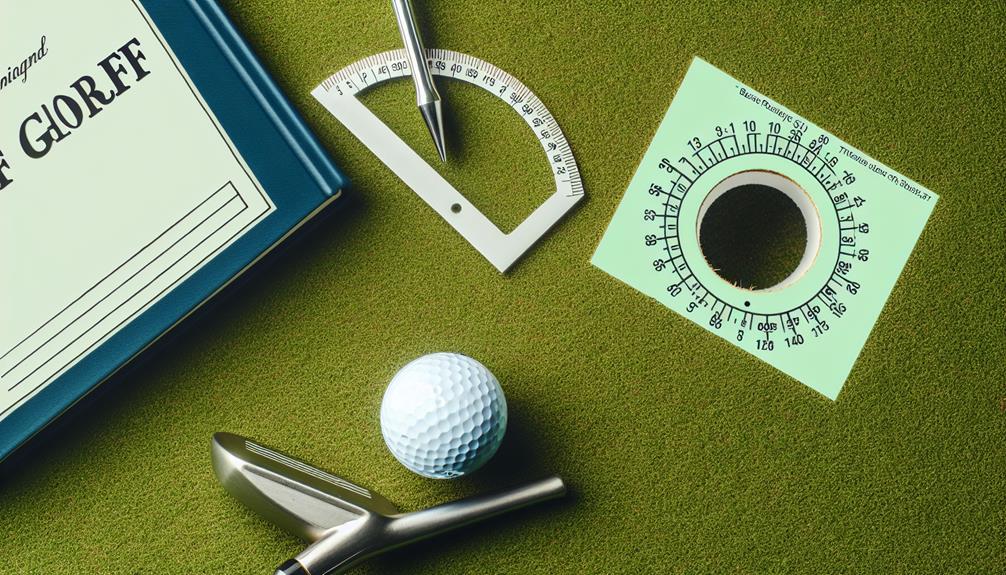Imagine you're navigating a ship through turbulent waters with nothing but an old, faded map for guidance. It's a bit like stepping onto the putting green without a solid understanding of the official rules, isn't it?
You're trying to make precise, calculated moves, but without clear directions, it's easy to veer off course. As a golfer, knowing the rules of the putting green is essential. They guide your strategy, influence your decisions, and can make or break your score.
It's not just about knowing when to mark, lift, or clean your ball—it's about mastering the complexities of the game. So, what if there was a way to make sense of these rules that seemed as clear as a calm sea?
Would you be interested in charting that course?
Understanding the Putting Green
To truly master your golf game, you need to get a grip on the intricacies of the putting green, the area of the course where precision and strategy truly come into play. A key aspect to consider is green etiquette. It's not just about playing the game, it's about respecting the course and your fellow players. You must avoid stepping on another player's line of putt or casting a shadow over their putt line. It's also important to repair any pitch marks you make on the green.
Now let's talk about putting techniques. A proper grip is vital. It's suggested to hold your club lightly, ensuring your palms face each other. Your stance should be balanced, feet shoulder-width apart, with the ball positioned slightly forward of the center. When you swing, let your shoulders lead the movement, not your wrists.
Understand that the speed at which you hit the ball affects its direction and distance. Mastering the speed is often the key to successful putting. It's a meticulous process, but with practice, you'll find your groove.
Marking, Lifting and Cleaning the Ball
When you're on the putting green, it's important to know how to correctly mark, lift, and clean your ball without violating the rules of the game. Ball identification techniques are key during this process. Use a marker or small coin to mark your ball's position before lifting it. Make sure the marker is placed directly behind the ball.
Once marked, you're allowed to lift your ball. Use your hand or a ball retriever, but ensure you don't twist or spin the ball, as this can alter its position.
Cleaning the ball is permitted under Rule 14.1, but you must exercise caution. Use a soft, damp cloth or towel to gently clean off dirt and debris to avoid damaging the ball or altering its characteristics.
The impact of weather conditions can't be overlooked in this process. Rain can make the ball slippery and difficult to handle, while wind might cause your marker to move. In such conditions, take extra care when marking, lifting, and cleaning your ball.
Repairing Damage on the Putting Green
On the putting green, you're allowed to repair damage like ball marks or old hole plugs, but it's crucial to understand the right way to do so without breaching golf rules. You must adhere to specific green maintenance practices to preserve the integrity of the course.
Start by identifying the damage. Ball marks usually leave a dent or depression on the green, and old hole plugs are noticeable from their distinct circular shape. Once identified, you can proceed to repair.
For ball marks, use a divot repair tool, carefully pushing the grass towards the center of the indent. Avoid lifting the soil upwards, as it can damage the putting surface.
For old hole plugs, a careful divot replacement technique is key. Gently replace the plug, ensuring it's level with the green's surface. In both cases, a gentle pat with the putter after repair helps restore the green to its original condition.
Rules for Ball Overhanging the Hole
In golf, you're likely to encounter a scenario where your ball, after a confident putt, teeters on the edge of the hole, not quite dropping in – a situation governed by specific rules. This is known as an Overhanging Ball Dilemma.
According to the rules of golf, you're allowed a reasonable amount of time to reach the hole and an additional ten seconds to see if the ball will fall in. If it doesn't drop after this time, it's deemed to be at rest. You must then play it from where it lies.
Hole Geometry Impact also plays a significant role in overhanging ball dilemmas. The shape and slope of the hole's rim can influence whether your ball drops in or remains precariously balanced. This is where the skill of reading the green comes into play.
Penalties and Exceptions on the Green
While understanding the dynamics of an overhanging ball dilemma is crucial, it's equally important to familiarize yourself with the penalties and exceptions that apply while you're on the green. One such rule to note pertains to 'Flagstick Interference'. If your ball hits the flagstick which wasn't removed, attended, or held up before your stroke, a two-stroke penalty is incurred in stroke play or loss of hole in match play.
However, there's an exception to this rule. If your ball was already on the green and a stroke was made from the putting green, no penalty is applied. This exception is part of the new rules introduced in 2019 to make the game more enjoyable and less complicated.
Penalty Strokes Reduction is another facet of the modern rules. In certain situations, a player can now repair almost any damage on the green, including spike marks and animal damage, without penalty. The aim is to ensure a smoother and fairer surface for all players.

